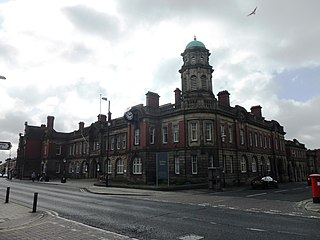
Northumberland is a county in North East England, one of the two counties in England that border on Scotland. Notable landmarks in the county include Alnwick Castle, Bamburgh Castle, Hadrian's Wall, Hexham Abbey and the tidal island Lindisfarne with the accompanying Lindisfarne Castle.

Congleton is a town and civil parish in the unitary authority of Cheshire East in Cheshire, England. The town is by the River Dane, 21 miles (34 km) south of Manchester and 13 miles (21 km) north of Stoke on Trent. At the 2011 Census, it had a population of 26,482.
An alderman is a member of a municipal assembly or council in many jurisdictions founded upon English law. The term may be titular, denoting a high-ranking member of a borough or county council, a council member chosen by the elected members themselves rather than by popular vote, or a council member elected by voters.

North Tyneside is a metropolitan borough in the metropolitan county of Tyne and Wear, England. It forms part of the greater Tyneside conurbation. North Tyneside Council is headquartered at Cobalt Park, Wallsend.

Morpeth is a historic market town in Northumberland, North East England, lying on the River Wansbeck. Nearby towns include Ashington and Bedlington. In the 2011 census, the population of Morpeth was given as 14,017, up from 13,833 in the 2001 census. The earliest evidence of settlement is believed to be from the Neolithic period, and some Roman artifacts have also been found. The first written mention of the town is from 1080, when the de Merlay family was granted the barony of Morpeth. The meaning of the town's name is uncertain, but it may refer to its position on the road to Scotland and a murder which occurred on that road. The de Merlay family built two castles in the town in the late 11th century and the 13th century. The town was granted its coat of arms in 1552. By the mid-1700s it had become one of the main markets in England, having been granted a market charter in 1200, but the opening of the railways in the 1800s led the market to decline. The town's history is celebrated in the annual Northumbrian Gathering.

Hexham is a constituency in Northumberland represented in the House of Commons of the UK Parliament since 2010 by Guy Opperman, a Conservative. As with all constituencies, the constituency elects one Member of Parliament (MP) by the first past the post system of election at least every five years.

Wansbeck is a constituency represented in the House of Commons of the UK Parliament since 2010 by Ian Lavery, a member of the Labour Party.

Blyth Valley, formerly known as Blyth, is a constituency represented in the House of Commons of the UK Parliament since 2019 by Ian Levy, a Conservative.

Berwick-upon-Tweed is a parliamentary constituency in Northumberland represented in the House of Commons of the UK Parliament since 2015 by Anne-Marie Trevelyan, a Conservative.
Castle Morpeth Borough Council elections were generally held every four years between the council's creation in 1974 and its abolition in 2009. Castle Morpeth was a non-metropolitan district in Northumberland, England. The council was abolished and its functions transferred to Northumberland County Council with effect from 1 April 2009.
This is a list of the High Sheriffs of the English county of Northumberland. The High Sheriff is the oldest secular office under the Crown. Formerly the High Sheriff was the principal law enforcement officer in the county but over the centuries most of the responsibilities associated with the post have been transferred elsewhere or are now defunct, so that its functions are now largely ceremonial. The High Sheriff changes every March.
Borough status is granted by royal charter to local government districts in England, Wales and Northern Ireland. The status is purely honorary, and does not give any additional powers to the council or inhabitants of the district. In Scotland, similarly chartered communities were known as royal burghs, although the status is no longer granted.

Northumberland County Council is a unitary authority in North East England. The population of the non-metropolitan unitary authority at the 2011 census was 316,028.

Widdrington is a village and a civil parish in the county of Northumberland, England. It borders Tritlington and West Chevington and East Chevington parishes to the north, the North Sea to the east, Cresswell and Ellington and Linton parishes to the south, and Widdrington Station and Stobswood parish to the west. In 2011 the parish has a population of 167.

Carlisle Park is a park located on the southern bank of the River Wansbeck in Morpeth, Northumberland. The park has the William Turner Garden, an aviary, a paddling pool, an ancient woodland, tennis courts, several bowling greens and a skate park. The park has one of the only four floral clocks in England, which was restored in 2018. In 2018, a statue of Emily Wilding Davison was erected in Carlisle Park, to commemorate 100 years since women were given the right to vote. The park has been awarded the Green Flag Award, the Love Parks Award in 2017, and 'Best Park' in Northumbria's in bloom competition in 2018.

Tritlington is a hamlet and former civil parish about 4 miles from Morpeth, now in the parish of Tritlington and West Chevington, in the county of Northumberland, England. Until 2009 Tritlington was in Castle Morpeth district. In 1961 the parish had a population of 216.
The county of Northumberland has returned four MPs to the UK Parliament since 1983. Under the Local Government Act 1972, which came into effect on 1 April 1974, the boundaries of the historic/administrative county were significantly altered with the south-east of the county, comprising more than half the electorate, being transferred to the new metropolitan county of Tyne and Wear. These changes were reflected in the following redistribution of parliamentary seats which did not come into effect until the 1983 general election, resulting in a reduction in the county's representation from 10 to 4 MPs.



















